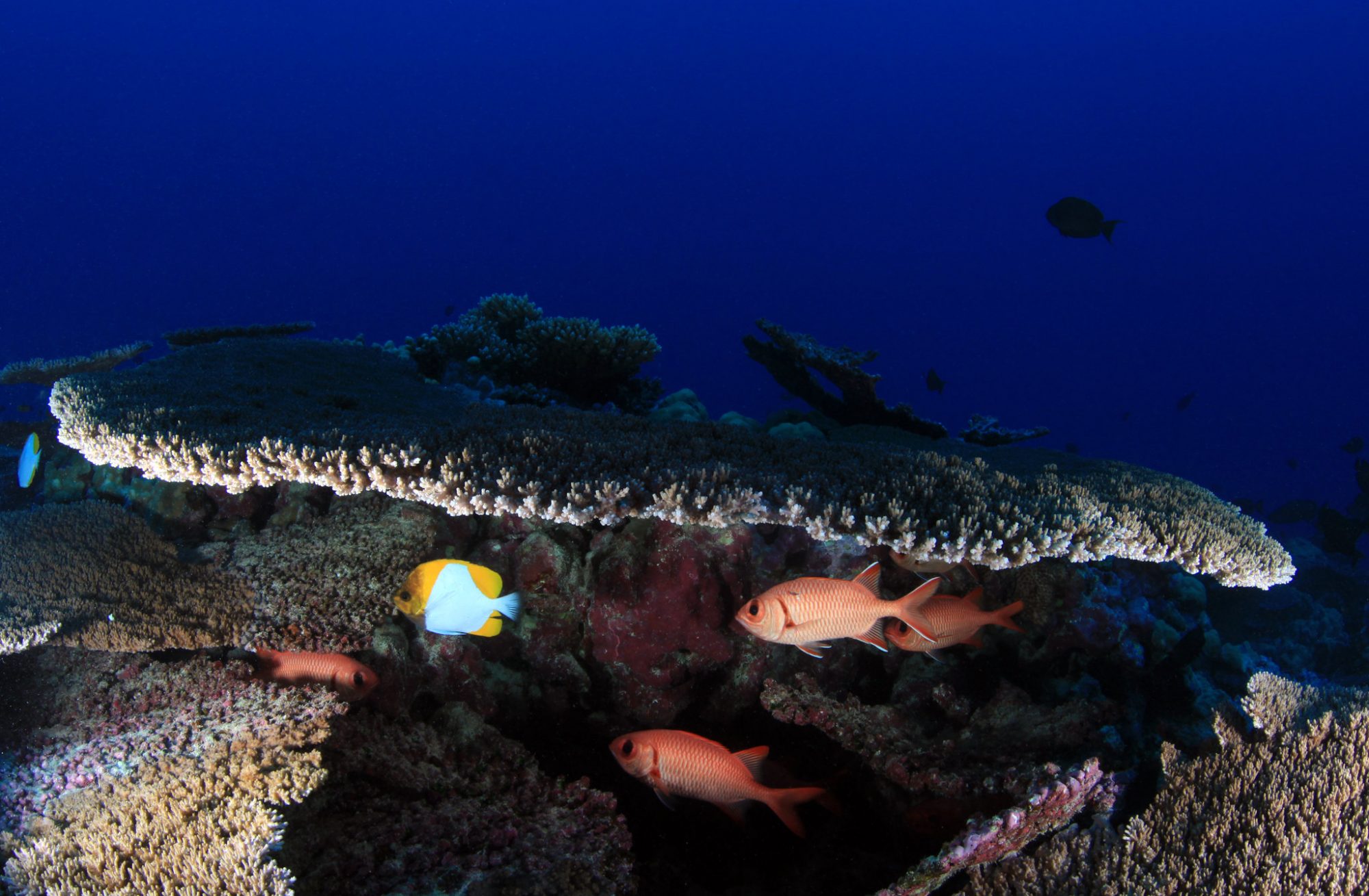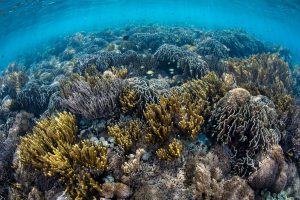Although there is no official word, it is highly likely the 15th Conference of the Parties to the Convention on Biological Diversity (CBD COP15), due to be held in Kunming this October, will be pushed back to next year, as the coronavirus epidemic has forced a number of preparatory meetings to be cancelled or delayed, stalling the already slow CBD negotiations process.
The epidemic makes the future of targets for global biodiversity – including in the ocean – even more uncertain. With economies suffering, how much money will there be for marine biodiversity? But some see opportunity. Li Shuo, senior global policy advisor with Greenpeace East Asia, says recent epidemics have almost all originated in animals, and the coronavirus exposes the possible health risks that arise when the relationship between humanity and nature falls out of balance.
Calls for a “Thirty by Thirty” target – to make 30% of the global ocean marine protected areas (MPAs) by 2030 – have been increasing. The target is already in the zero draft for CBD COP15, and it is the clearest and most widely supported of the proposals to the conference.
Marine Protected Areas cover 7.43% of the ocean

But the slow pace of progress over the last decade, often inadequate marine protection where it does exist, and the current precarious state of negotiations over mechanisms to protect the high seas all point to the huge challenge of achieving the goal. Even if the political will to add it to the Kunming targets is there, actually fulfilling that commitment within the next ten years looks to be an impossible task.
Aichi failures
As early as 2000, scientists were calling for 30% of the ocean to be protected in order to preserve biodiversity. In 2003, the World Park Congress proposed strict protections for at least 20-30% of the ocean by 2012. Unfortunately, a lack of political will meant that parties to the CBD scaled back ambitions in 2010, calling for protection of only 10% of coastal and marine areas. That became Aichi Target 11, named for the Japanese prefecture where the 2010 talks took place.
Ten years later, when reviewing the performance of the 196 parties to the CBD, there is no denying that even the 10% target has been missed. Although the CBD doesn’t make official data on protected ocean areas available, the International Union for the Conservation of Nature calculated from national data that only 7.43% of the ocean worldwide was protected as of 12 April 2020.
The Aichi target was more concerned with the quantity of MPAs than the quality. It called for such areas to be “conserved through effectively and equitably managed, ecologically representative and well-connected systems.” But much research has shown that MPAs are only effective when extractive practices such as fishing and mining are banned.
When you look at the quality of protections, that 7.43% achievement seems even less impressive. First, this is just a simple total of nationally reported figures, and many of the MPAs are “paper parks”, existing only in government documents. Some are merely proposals, years away from implementation. Second, the vast majority of these MPAs still allow the use of various types of resources. After examining the data, the Marine Conservation Institute found that only 2.5% of the ocean could be classed as highly protected, with only light extractive activities allowed.
Kristina Gjerde, senior high seas advisor to the IUCN, told China Dialogue: “So to me the definition of MPA needs to talk about everything [being] managed for conservation, and MPAs today don’t. They are just more like marine planning exercises.” She explained that the IUCN places MPAs in one of six categories, according to the level of protection, with Category V and VI allowing the sustainable use of natural resources. “It means more sustainable use for local communities. It doesn’t mean commercial fishing. And so if you start to scrutinise how many MPAs are open to commercial fishing, and said ‘no, they should not be really qualified MPAs’, your numbers will go way down.”
Trouble on the high seas
Calls to implement the Thirty by Thirty target have gathered force among scientists, international organisations, the media and the public, and can no longer be ignored. But nor can two problems: First, given the lessons learned from the Aichi process, can we fulfil this goal? Second, how? This brings us to high seas governance.
The CBD aims to protect global biodiversity. But its signatories – sovereign states – can only create MPAs within their jurisdiction, not for the high seas. Aichi Target 11 did not specify if that 10% was to be in marine areas within national jurisdiction, or to cover the high seas. Currently, the vast majority of MPAs fall within national jurisdictions.
61%
the proportion of the ocean considered international waters
But only 39% of the ocean falls within national jurisdiction, with the remaining 61% being international waters. Thus, achieving the 30% protection target would require protecting almost 80% of domestic waters. This is clearly unrealistic.
In other words, the tools currently at the CBD’s disposal do not allow it to reach the Thirty by Thirty target. Either it comes up with new mechanisms, or the 196 signatories achieve that target via other international platforms or tools.
There is no widely used method for managing MPAs on the high seas. In 2004, talks started on marine biodiversity beyond areas of national jurisdiction (BBNJ), under the UN Convention on the Law of the Sea. After 16 years of talks and three formal intergovernmental negotiations in the last two years, there is hope for a binding treaty on the high seas. The MPA articles of that treaty would be an important tool for the CBD in achieving its targets.
It is as if 196 people decided to cross an ocean over the course of a decade. Their aim is set but they have no means of transport. The first order of business is to find or fashion one. How long will that take? This is the crucial issue for high seas protection today. A BBNJ treaty looks the most plausible “boat” – but the coronavirus has forced a fourth intergovernmental meeting planned for March and April to be postponed.
The outlook for the BBNJ talks is unclear, said Zheng Miaozhuang, associate researcher with the Ministry of Natural Resources’ Marine Development Strategy Institute and deputy head of its Ocean Environment Resources Research Office. “Although there is quite a bit of consensus on MPAs, there are four topics that need to be resolved at once: marine genetic resources, including questions on the sharing of benefits; environmental impact assessments; capacity building and the transfer of marine technology. Even if progress is made on MPAs, there will be no agreement if the other three topics aren’t also concluded.”
What targets do we need?
Given the inadequacy of existing MPAs and the lack of high seas governance mechanisms, is it possible to protect 30% of the ocean within ten years? And is it even a worthwhile target?
Many scientists are questioning such “numbers first” targets. Over the last decade, some countries have hastily set up MPAs to meet Aichi Target 11 – but with poor protections. According to Megan D. Barnes and others in a paper published in 2018, such targets result in a focus on establishing protected areas but give the false impression that conservation is actually taking place: “It would be inconceivable to monitor healthcare provision based on available beds (quantity) irrespective of the presence of trained medical staff (quality) or whether patients live or die (outcome).”
Although scientists have produced methods to better evaluate the effectiveness of a protected area, these rarely come up in international negotiations or make it into treaty texts. The detail and complexity of scientific research tends not to survive a policymaking process involving 196 parties. So while numeric targets may suffer from being a blunt instrument, this is also their strength. “Quantified targets are easy to report on and assess. In this sense, of all the Aichi targets, the one on the extent of MPAs is the easiest to understand and evaluate,” Li Shuo said. “Look at the first of the Aichi targets: ‘By 2020, at the latest, people are aware of the values of biodiversity and the steps they can take to conserve and use it sustainably.’ What’s the point in a target when there’s no way to measure success?”
Observers generally think numeric targets are a powerful tool. The 30% aim remains bracketed in the Kunming zero draft, meaning it requires further discussion, but it is a start. Chen Jiliang, a high seas conservation researcher with NGO Greenovation Hub, doesn’t think it’s a choice between quality or quantity – both are necessary.
The Thirty by Thirty target has strong support from the UK, the EU, Canada, Costa Rica and the Seychelles. “Nobody has been explicitly opposed to it during talks. But a lot of countries haven’t commented on the actual number, and some of them may have reservations about it,” said Li Shuo.
The weakness of the CBD is that it lacks teeth
More important is how the target will be implemented. After the 10% target was announced, countries themselves decided what action to take, then submitted reports they produced themselves. It is as if students submit homework which never gets marked, but is just left on a desk to be read by anyone who might be interested. This has led to the CBD being described as toothless.
“Setting conservation targets is one thing, implementing them is another,” said Zheng Miaozhuang. He thinks that while the Thirty by Thirty target has gathered plenty of political will, “if like the Aichi Target 11 it is never achieved or creates MPAs that exist only on paper and in words, it doesn’t matter how ambitious is it.”
But multilateral processes often set lofty targets which, though never met, result in progress during implementation. Kristina Gjerde told China Dialogue that while many protected areas aren’t well managed and may not be worthy of the name, encouragement is needed for improvement: simply pointing out these aren’t really MPAs won’t help.
Chen Jiliang thinks the parties to the CBD should support an ambitious target: “Without that target, there’s no reason to mobilise the resources to achieve it.”
During talks on marine conservation targets, China has always stressed feasibility and a combination of quality and quantity. Zheng Miaozhuang said the 5th Working Report of the CBD, originally due to be published in the first half of this year, would review national implementation of Aichi Target 11. This would help set targets for marine protection under the CBD’s post-2020 framework. However, the coronavirus means it will likely be delayed.
One researcher with the Ministry of Natural Resources who participated in the talks and has requested anonymity said that China is taking a conservative stance on a numeric target. He thinks clarity will be needed on what is meant by “ocean”, as the post-2020 targets cover marine areas under national jurisdiction – and two-thirds of the ocean is international waters.
Nor is Li Shuo particularly optimistic. “The negotiation process is more than halfway over, and everyone’s still talking about designing targets, with less discussion of implementation and funding. Is that going to convince people the Kunming process has learned lessons from Aichi?”
Enric Sala, marine ecologist and National Geographic explorer-in-residence, said in an email to China Dialogue that “COVID-19 has already changed the world, and everyone can realise that our relationship with nature is broken and that we have to fix it. This is why I hope that Kunming will change history not only by agreeing to ambitious targets for nature conservation, but also by establishing mechanisms to optimise and monitor conservation outcomes. We cannot make big announcements and promises without a real commitment to follow up.”







![A man is seen looking up at the sky from his doorway before the hit of the Cyclone Amphan.Super Cyclone Amphan hits West Bengal with a speed of 130 kmph on the afternoon of 20th May [image: Alamy]](https://dialogue.earth/content/uploads/2020/05/Cyclone-Amphan-300x214.jpg)
